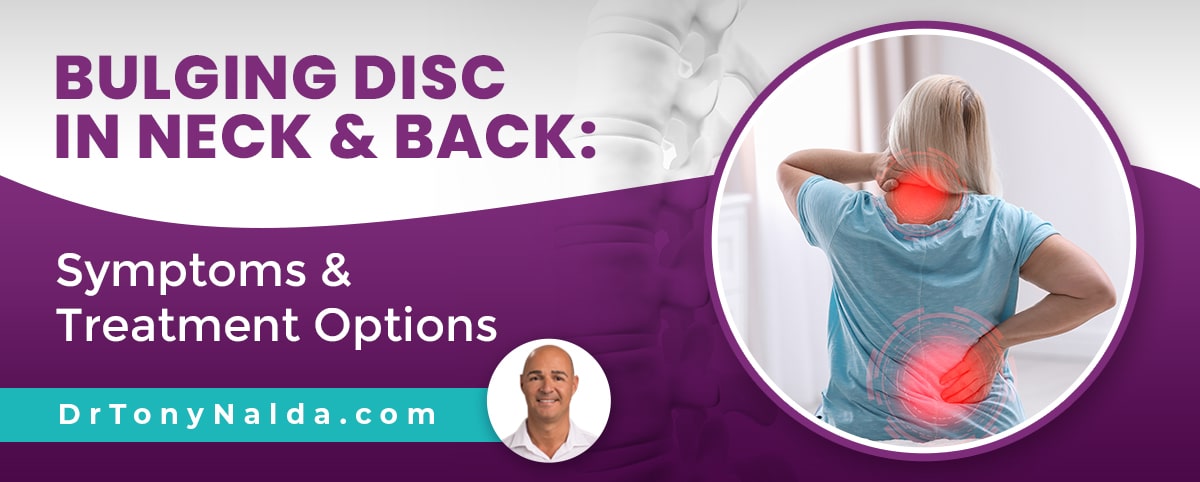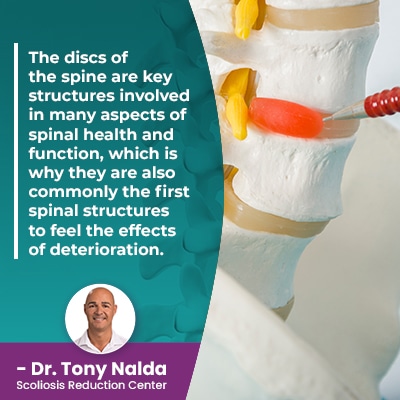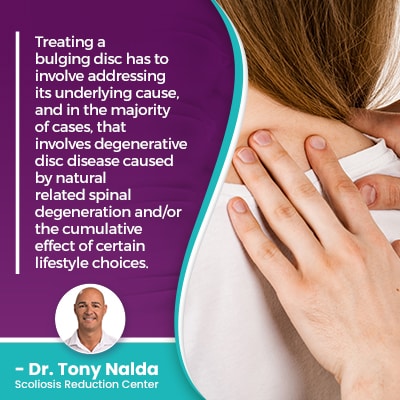Bulging Disc In Neck & Back: Symptoms & Treatment Options

A bulging disc in the neck and back means a spinal disc's inner nucleus is pushing out against its outer annulus, and this can occur in any of the spine's main sections. A bulging disc can cause a wide range of symptoms based on its location, severity, and cause, and if left untreated, it can become a herniated disc.
Spinal structures work together to facilitate strength, flexibility, and function. Adjacent vertebrae are separated by an intervertebral disc, and a bulging disc means its inner nucleus is pushing outwards against its surrounding annulus, causing a loss of space within and around the spine.
To better understand the effects of a bulging disc, let's first address the many roles intervertebral discs play in maintaining the spine's healthy curves and alignment.
Table of Contents
Healthy Spinal Anatomy
The spine's design is based on movement, so its individual parts work together to facilitate this, and the spine's natural curves make it stronger, more flexible, and better able to handle mechanical stress incurred during activity.
If the spine's healthy curves are in place, this means its vertebrae are aligned as they should be, and the health of the spinal discs are an important part of that.
The spine has three main sections: the cervical spine (neck), thoracic spine (middle/upper back), and the lumbar spine (lower back).
Each of the spine's main sections has its own characteristic curvature type and consists of bones called vertebrae stacked on top of one another in a straight and neutral alignment, and adjacent vertebral bodies are separated by an intervertebral disc.
Intervertebral Discs
 The discs of the spine are key structures involved in many aspects of spinal health and function, which is why they are also commonly the first spinal structures to feel the effects of deterioration.
The discs of the spine are key structures involved in many aspects of spinal health and function, which is why they are also commonly the first spinal structures to feel the effects of deterioration.
And remember, the spine doesn't just facilitate movement and give the body structure, it also works in tandem with the brain to form the central nervous system (CNS), so spinal conditions also affect the spinal nerves within the spinal cord, and as they branch out into different areas of the body.
When a spinal nerve is compressed, it can cause a number of symptoms, and a bulging disc can cause compression of nearby nerves.
The spinal discs consist of two main structures: a soft gel-like inner nucleus and a tough outer layer known as the annulus.
Healthy spinal discs are plump, hydrated, and its inner nucleus maintains a central position inside its surrounding annulus.
What is a Bulging Disc?
If a disc starts to degenerate, which commonly involves it becoming desiccated, this causes its inner nucleus to lose height and start to push outwards (picture a marshmallow being held between two crackers with pressure applied from above and below).
If the inner nucleus is pushing out against its outer annulus, the disc itself is bulging outwards around its perimeter, and this means the disc is taking up space within and around the spine that is also being used by its vertebrae and surrounding nerves.
If the spinal canal and its spinal nerves and nerve roots are exposed to uneven pressure because a disc has changed shape and is compressing its surroundings, sharp pain can become an issue, along with other symptoms such as back or neck pain, leg pain, shooting pain, muscle weakness, and issues with bowel control.
In most spinal conditions, the majority of the condition's effects are going to be felt in the area of the body located the closest to the affected spinal section, so if a disc is bulging in the neck, neck pain and pain in the shoulder blades is common.
A bulging disc in the lumbar spine is known to cause related sciatic nerve pain because the sciatic nerve starts in the lumbar spine so if the lumbar spine has experienced a loss of space because of a bulging disc, sciatic nerve compression can cause a number of symptoms that affect the lower body.
Also known as a slipped disk, a bulging disc can become a herniated disc if left untreated, and this means the inner nucleus bulging outwards has caused a tear in its outer layer, and its inner nucleus is spilling out through the tear.
Part of the reason the discs are often the first spinal structures to feel the effects of deterioration are because they are the largest structures in the body without their own vascular supply: a direct path in and out of the discs through which waste can be eliminated, and blood containing oxygen and nutrients needed for repair can pass.
So disc damage is difficult, if not impossible, to reverse, and as disc degeneration takes place slowly over time, the process of working towards a reversal of that damage can be equally slow.
Treatment Options for a Bulging Disc
When it comes time to treat a bulging disc, this is important because if left untreated, it can worsen and become a herniated disc.
Treating a bulging disc has to involve addressing its underlying cause, and in the majority of cases, that involves degenerative disc disease caused by natural related spinal degeneration and/or the cumulative effect of certain lifestyle choices.
 There is a natural amount of spinal degeneration to be expected with age, but there are certain lifestyle choices that can also contribute to a person's level and rate of spinal degeneration, and this involves leading a spine-friendly lifestyle.
There is a natural amount of spinal degeneration to be expected with age, but there are certain lifestyle choices that can also contribute to a person's level and rate of spinal degeneration, and this involves leading a spine-friendly lifestyle.
Over time, carrying excess weight can strain the spinal joints causing instability and straining the discs, and leading a sedentary lifestyle is contrary to the spine's movement-based design and contributes to disc desiccation as good circulation around the discs is how they absorb nutrients needed for repair.
Not drinking enough water and/or excessive consumption of alcohol and smoking can also contribute to disc desiccation and faster rates of disc degeneration, as can chronic poor posture and repeatedly lifting heavy objects incorrectly and straining the spine and its discs.
So if natural age-related spinal degeneration is the cause, treatment is all about preserving disc function by addressing any spinal misalignment through condition-specific chiropractic care, and improving circulation around an affected disc through physical therapy and a series of condition-specific exercises.
Physical therapy can also help by increasing a patient's core strength as this means increased support for the spine, taking pressure off its individual vertebra and discs in between.
If lifestyle factors are an issue, then lifestyle guidance and improvement is a key facet of treatment, and if another spinal condition is the cause, the underlying spinal condition causing the excessive spinal degeneration has to be addressed proactively.
Conclusion
Here at the Scoliosis Reduction Center, I have a wide range of experience treating a variety of spinal conditions/issues, bulging discs included.
If a disc is bulging in the cervical spine, its main effects are going to be felt by the neck and its surroundings, and if a disc is bulging in the lumbar spine, it's going to mainly affect the lower body.
Discs can bulge in any of the spine's main sections, but they occur most often in the lumbar spine; not only does the lumbar spine have to support the weight of the entire trunk and the spinal sections above, it also feels the effects of bending, twisting, and lifting motions.
When it comes to nerve compression, disk degeneration is a common cause because it means a disc's shape can change, often due to desiccation, causing it to encroach on space within and around the spine, putting adverse pressure on the spinal cord, through which the spinal nerves need to pass and branch out.
If a disc is bulging, this means its inner gel-like nucleus is pushing outwards against its outer durable layer, known as the annulus, and if a bulging disc is left untreated and gets worse, the bulging disc can cause a tear in the annulus, through which its inner nucleus herniates, becoming a herniated disk.
A bulging disc is commonly caused by disc degeneration and desiccation, and degenerative disc disease is a contributing factor behind the development of a number of spinal conditions/issues.
If pressure on the spinal cord is caused by the presence of a spinal condition such as scoliosis, stenosis, or cauda equina syndrome, the underlying spinal condition, as the cause, has to be the focus of treatment.
When disc degeneration and lifestyle factors are the cause of a bulging disc, treatment involves chiropractic care to focus on correcting any spinal misalignment and relieving pressure on the spinal cord and affected nerve roots.
Physical therapy and a variety of therapeutic exercises can also help with increasing core strength so the spine's surrounding muscles can optimally support it, taking pressure off its individual structures (discs), and improving circulation around an affected disc.
Dr. Tony Nalda
DOCTOR OF CHIROPRACTIC
After receiving an undergraduate degree in psychology and his Doctorate of Chiropractic from Life University, Dr. Nalda settled in Celebration, Florida and proceeded to build one of Central Florida’s most successful chiropractic clinics.
His experience with patients suffering from scoliosis, and the confusion and frustration they faced, led him to seek a specialty in scoliosis care. In 2006 he completed his Intensive Care Certification from CLEAR Institute, a leading scoliosis educational and certification center.
About Dr. Tony Nalda
 Ready to explore scoliosis treatment? Contact Us Now
Ready to explore scoliosis treatment? Contact Us Now





